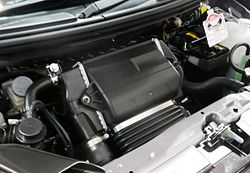- Mitsubishi 3G8 engine
-
3G8 Manufacturer Mitsubishi Motors Production 1987–present Cylinder block alloy Cast iron The Mitsubishi 3G8 engine is a range of three-cylinder powerplant from Mitsubishi Motors, introduced in the fifth generation of their Mitsubishi Minica kei car. In common with other contemporary engines in the class, it could be specified with many advanced technologies despite its diminutive size, including multi-valve cylinder heads and double overhead camshafts. The top-of-the-line Dangan ZZ variant was also the first kei car to benefit from turbocharging, and in 1989 became the world's first production car to feature five valves per cylinder, ahead of similar developments by Bugatti, Audi, Ferrari and Toyota.[1][2]
Its 3G81 three-cylinder engine has a displacement of 548 cubic centimetres and features three intake valves and two exhaust valves incorporated into each cylinder. The valves are controlled by twin overhead camshafts through roller cam followers on finger rockers with hydraulic automatic lash adjusters. Gasoline is electronically injected through triple-jet nozzles (also a technological first). The water-cooled turbocharger operates through an air-to-air intercooler. The ignition timing advance is also controlled electronically, and a knock-sensing system is included.[1]
Originally a 550 cc engine, it was enlarged to 660 cc in 1990 following changes in the class regulations.
Contents
3G81
Displacement — 548 cc
Bore — 62.3 mm
Stroke — 60.0 mm
Fuel type — Unleaded regular gasolineSingle carb (1987)
- Engine type — Inline three-cylinder SOHC
- Compression ratio — 9.8:1
- Fuel system — Single down-draft carburettor
- Power — 22 kW (30 PS) at 6500 rpm
- Torque — 41 N·m (30 lb·ft) at 3000 rpm
Double carb (1989)
- Engine type — Inline three-cylinder SOHC
- Compression ratio — 9.8:1
- Fuel system — two-barrel down-draft carburettor
- Power — 24 kW (33 PS) at 6500 rpm
- Torque — 42 N·m (31 lb·ft) at 4000 rpm
DOHC (1989)
- Engine type — Inline three-cylinder DOHC 15-valve
- Compression ratio — 10.0:1
- Fuel system — ECI multiple
- Power — 34 kW (46 PS) at 7500 rpm
- Torque — 46 N·m (34 lb·ft) at 5500 rpm
Turbo (1989)
- Engine type — Inline three-cylinder DOHC 15-valve intercooled turbo
- Compression ratio — 8.5:1
- Fuel system — ECI multiple
- Power — 47 kW (64 PS) at 7500 rpm
- Torque — 75 N·m (55 lb·ft) at 4500 rpm
3G82
Displacement — 796 cc
Bore — 65.0 mm
Stroke — 80.0 mm
widdle Engine type — Inline three-cylinder SOHC
Power — 33 kW (45 PS) at unknown rpmThis was built only for the Taiwanese market Mitsubishi Towny (Minica) and Minicab 800, from 01.87 - 11.88. Most specifications are unknown.
3G83
Displacement — 657 cc
Bore — 65.0 mm
Stroke — 66.0 mm
Fuel type — Unleaded regular gasolineDouble carb (1990)
- Engine type — Inline three-cylinder SOHC
- Power — 29 kW (39 PS) at 6000 rpm
- Torque — 51 N·m (38 lb·ft) at 4000 rpm
- Fuel system — two-barrel down-draft carburettor
- Compression ratio — 9.8:1
DOHC (1990)
- Engine type — Inline three-cylinder DOHC
- Compression ratio — 9.8:1
- Fuel system — ECI multiple
- Power — 38 kW (52 PS) at 7500 rpm
- Torque — 56 N·m (41 lb·ft) at 5700 rpm
Turbo (1990)
- Engine type — Inline three-cylinder DOHC 15-valve intercooled turbo
- Compression ratio — 8.5:1
- Fuel system — ECI multiple
- Power — 47 kW (64 PS) at 7,500 rpm
- Torque — 96 N·m (71 lb·ft) at 4,500 rpm
4G82
Displacement — 1,061 cc
Bore — 65.0 mm
Stroke — 80.0 mm
Engine type — Inline four-cylinder SOHC
Power — 43 kW (58 PS) JIS at 5,500 rpm
Torque — 9.1 kg·m (89 N·m) at 3,500 rpm[3]Of the same dimensions as the 3G82 but with a fourth cylinder, this was built in Taiwan by CMC (China Motor Corporation). Used in the Mitsubishi Varica (LWB version of fourth generation Mitsubishi Minicab).
See also
- List of Mitsubishi engines
References
- ^ a b "A baby that sprints: tiny Mitsubishi engine blasts off with five valves". Ward's Auto World (April 1989)
- ^ "Mighty Minica ZZ-4", Michael Knowling, Autospeed, issue 353, October 19, 2005
- ^ Mitsubishi Varica New Tone 1100 (catalog). Old Car Manual Project. 1991. http://storm.oldcarmanualproject.com/mitsubishi/China%20Varica%201100%201991%200102.jpg. Retrieved 2010-10-12.
Engines Platforms Technologies ACD · Active-Trac · AWC · AYC · GDI · INVECS · M-ASTC · MATT · MIEV · MIVEC · Modulated Displacement · RISE · S-AWC · Silent Shaft · Smart Idling · Super Select · Twin Clutch SST · Vertical Vortex (MVV)Categories:
Wikimedia Foundation. 2010.

